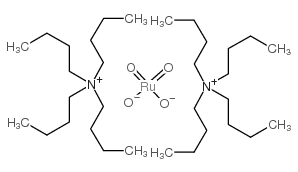96317-72-5
| 中文名 | 四丁基过钌酸铵 |
|---|---|
| 英文名 | Tetrabutylammonium perruthenate TBAP |
| 英文别名 |
Tetrabutylammoniumperruthenate,min.TBAP
TETRABUTYLAMMONIUM PERRUTHENATE TBAP TBAP TETRABUTYLAMMONIUM PERRUTHENATE |
| 熔点 | 157ºC (dec.) |
|---|---|
| 分子式 | C32H72N2O4Ru |
| 分子量 | 649.99500 |
| 精确质量 | 650.45400 |
| PSA | 80.26000 |
| LogP | 9.53200 |
| 更多 | 1. 性状:未确定 2. 密度(g/mL,25℃):未确定 3. 相对蒸汽密度(g/mL,空气=1):未确定 4. 熔点(ºC):157 5. 沸点(ºC,常压):未确定 6. 沸点(ºC,2mmHg):未确定 7. 折射率(n20/D):未确定 8. 闪点(ºC):未确定 9. 比旋光度(º):未确定 10. 自燃点或引燃温度(ºC):未确定 11. 蒸气压(mmHg,20ºC):未确定 12. 饱和蒸气压(kPa,25ºC):未确定 13. 燃烧热(KJ/mol):未确定 14. 临界温度(ºC):未确定 15. 临界压力(KPa):未确定 16. 油水(辛醇/水)分配系数的对数值:未确定 17. 爆炸上限(%,V/V):未确定 18. 爆炸下限(%,V/V):未确定 19. 溶解性:未确定 |
|
Section 1: Product Identification Chemical Name:Tetrabutylammonium perruthenate, min. 97% TBAP CAS Registry Number:96317-72-5 Formula:(C4H9)4N+RuO4- EINECS Number:none Chemical Family:Alkylammonium salt Synonym:TBAP
Section 2: Composition and Information on Ingredients IngredientCAS NumberPercentACGIH (TWA)OSHA (PEL) Title Compound96317-72-5100%no datano data Section 3: Hazards Identification Emergency Overview:Irritating to skin, eyes and respiratory tract. Primary Routes of Exposure:Ingestion Eye Contact:Causes slight to mild irritation of the eyes. Skin Contact:Causes slight to mild irritation of the skin. Inhalation:Irritating to the nose, mucous membranes and respiratory tract. Ingestion:Ingestion may lead to dizziness, abdominal cramps, vomiting, bloody diarrhea, weakness, and convulsions. Acute Health Affects:Irritating to skin, eyes and respiratory tract. No information available on long-term chronic effects. As a strong oxidant anion, and by analogy to similar Chronic Health Affects: salts of other elements, one might expect chronic effects. NTP:No IARC:No OSHA:No SECTION 4: First Aid Measures Immediately flush the eyes with copious amounts of water for at least 10-15 minutes. A victim may need Eye Exposure: assistance in keeping their eye lids open. Get immediate medical attention. Wash the affected area with soap and water. Remove contaminated clothes if necessary. Seek medical Skin Exposure: assistance if irritation persists. Remove the victim to fresh air. Closely monitor the victim for signs of respiratory problems, such as difficulty Inhalation: in breathing, coughing, wheezing, or pain. In such cases seek immediate medical assistance. Ingestion:Seek medical attention immediately. Keep the victim calm. Give the victim water (only if conscious). SECTION 5: Fire Fighting Measures Flash Point:no data Autoignition Temperature:no data Explosion Limits:no data Extinguishing Medium:water, carbon dioxide, dry powder or foam If involved in a fire, fire fighters should be equipped with a NIOSH approved positive pressure self-contained Special Fire Fighting Procedures: breathing apparatus and full protective clothing. Hazardous Combustion andIf involved in a fire this material may emit toxic organic fumes. Decomposion Products: Oxidizing solid. Rapid heating may cause this compound to explode. Dust may form an explosive mixture with Unusual Fire or Explosion Hazards: air. SECTION 6: Accidental Release Measures Spill and Leak Procedures:Small spills can be mixed with vermiculite or sodium carbonate and swept up. SECTION 7: Handling and Storage Handling and Storage:Store cold in a sealed container. Keep away from heat and moisture. SECTION 8: Exposure Controls and Personal Protection Eye Protection:Always wear approved safety glasses when handling a chemical substance in the laboratory. Skin Protection:Wear appropriate chemical resistant gloves and protective clothing. Ventilation:Material may form a fine dust. If possible, handle the material in an efficient fume hood. If in form of fine dust and ventilation is not available a respirator should be worn. The use of respirators Respirator: requires a Respirator Protection Program to be in compliance with 29 CFR 1910.134. Ventilation:Material may form a fine dust. If possible, handle the material in an efficient fume hood. Additional Protection:No additional protection required. SECTION 9: Physical and Chemical Properties Color and Form:green xtl. Molecular Weight:407.41 Melting Point:157° dec. Boiling Point:none Vapor Pressure:no data Specific Gravity:no data Odor:none Solubility in Water:insoluble SECTION 10: Stability and Reactivity Stability:air and moisture stable (store cold) Hazardous Polymerization:no hazardous polymerization Conditions to Avoid:Rapid heating. Concentrated oxidizing acids may produce toxic volatile ruthenium tetroxide. Incompatibility:nitric acid, perchloric acid, chlorine, reducing agents and combustible powders. Decomposition Products:Carbon dioxide, carbon monoxide, organic vapors, and ruthenium oxide. SECTION 11: Toxicological Information RTECS Data:No information available in the RTECS files. Carcinogenic Effects:No data available Mutagenic Effects:No data available Tetratogenic Effects:No data available SECTION 12: Ecological Information Ecological Information:No information available SECTION 13: Disposal Considerations Disposal:Dispose of according to local, state and federal regulations. SECTION 14: Transportation Shipping Name (CFR):Oxidizing Solid, N.O.S. Hazard Class (CFR):5.1 Additional Hazard Class (CFR):NA Packaging Group (CFR):II UN ID Number (CFR):UN #1479 Shipping Name (IATA):Oxidizing Solid, N.O.S. Hazard Class (IATA):5.1 Additional Hazard Class (IATA):NA Packaging Group (IATA):II UN ID Number (IATA):UN #1479 SECTION 15: Regulatory Information TSCA:Not listed in the TSCA inventory. SARA (Title 313):Title compound not listed. Second Ingredient:none SECTION 16 - ADDITIONAL INFORMATION N/A |
| 风险声明 (欧洲) | R8;R36/37/38 |
|---|---|
| 安全声明 (欧洲) | S17;S26;S36/S37/S39 |
| 危险品运输编码 | UN 1479 |
| 海关编码 | 2923900090 |
| 海关编码 | 2923900090 |
|---|---|
| 中文概述 | 2923900090 其他季铵盐及季铵碱。监管条件:无。增值税率:17.0%。退税率:9.0%。最惠国关税:6.5%。普通关税:30.0% |
| 申报要素 | 品名, 成分含量, 用途 |
| Summary | 2923900090 other quaternary ammonium salts and hydroxides。Supervision conditions:None。VAT:17.0%。Tax rebate rate:9.0%。MFN tariff:6.5%。General tariff:30.0% |


